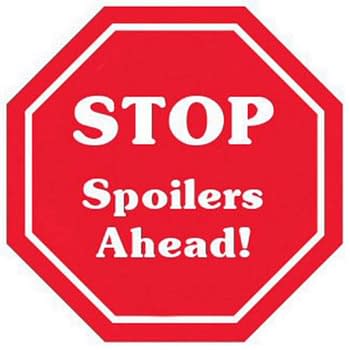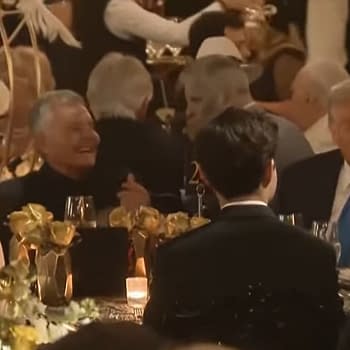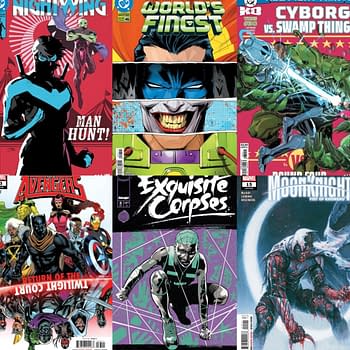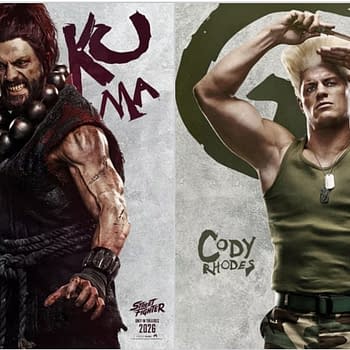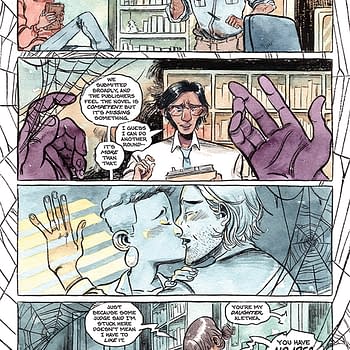Posted in: Comics | Tagged: jimmy palmiotti, joe quesada, marvel knights, tripwire
Joe Quesada And Jimmy Palmiotti On Marvel Knights From 1998

JOE QUESADA and JIMMY PALMIOTTI have been given the enviable task of relaunching five of Marvel's classic characters: Daredevil, Black Panther, The Inhumans, The Punisher and Doctor Strange. TRIPWIRE caught up with Joe and Jimmy in New York in April to find out all about the Marvel Knights, as well as quizzing fellow creators Kevin Smith, Jae Lee, Paul Jenkins, Tony Harris and Dan Jolley about their contributions to the line…
What's at the heart of Marvel Knights? It's everything that we'd like to be able to do with these characters and hopefully more", Joe Quesada explains to me in between a mouthful of pretzels in the Event offices.
Quesada and Palmiotti have built up a reputation in their years in the industry. When Marvel announced that they were going to be taking over four of their key titles, the first industry reaction was bemusement. Why, when Heroes Reborn failed so miserably, did they want to have another go at the concept, only with two creators who were less well-known that the two initially involved with that project? Joe Quesada doesn't see the similarities:
"[Heroes Reborn] was essentially a pocket universe. We're not redesigning all these characters, because change is a terrible thing sometimes. Changing a character's costume is a real quick fix and it doesn't really change the character. We want to try and take the higher road on this and say ÔYou should buy these books not because of the costume but the content".
The way that the deal came about was unexpected to say the least. Rather than the two creators pitching the idea to Marvel, Quesada and Palmiotti were approached by Marvel's President, Joseph Calamari. In a way, Marvel Knights is a logical progression in the development of Marvel, Quesada feels:
"He wanted to speak with Jimmy [Palmiotti] and I and get our thoughts on the state of the industry. The first lunch meeting led to another meeting, which led to the question ÔWould you guys consider packaging stuff, not like the Heroes Reborn thing, but within current Marvel continuity, working hand in hand with editorial?'. Obviously, we were really interested."
Joe grabs another handful of pretzels (there's a giant sack of the things sitting on the floor of Event's spacious office situated on the thirteenth floor of Marvel's offices) and continues:
"Joseph Calamari's very concerned about the state of Marvel and how they can improve the company, not just from a financial standpoint. He understands that the key to selling more books is to do better books and I think that, even before Jimmy and I got here, there's been a noticeable improvement in Marvel's titles."
Essentially, Marvel Knights takes characters that haven't really had much exposure recently. These are all characters that Quesada and Palmiotti have always dreamed about working on:
"The characters that we fancied creating new stuff with were always the characters that we considered second tier and they just haven't had their moment in the sun. These characters require a lot of motivation and creative juices from the writers and artists to keep it fresh and interesting."
Palmiotti intercedes. With the two creators, it's like interviewing a comedy double act: Quesada is the straight man to Palmiotti's comedian but Palmiotti is not to be underestimated:
"With characters like The Inhumans, there's never been a lot of energy spent focusing on them and, with Paul Jenkins writing that book, he is going to flesh out some really great stuff. Add to that Jae Lee visuals and you've got an exciting series".
"The thing with the Inhumans", Quesada returns to the conversation "is that their back story's been told but it's been told in excerpts of other books. This is an opportunity to really get to grips with this."
Continued on page 24
Paul Jenkins has just come off a long run on Vertigo's Hellblazer series. When I talked to him at home, he didn't seem concerned at the difference between writing a wise cracking Scouse magician and Marvel's premiere Royal Family:
"What you have here, I think, is a wealth of untapped possibilities as far as the heroic myth concept is concerned. You have a city that's home to two or three thousand unique individuals – a perfect opportunity to ponder "What if?" in the printed pages of a comic book."
In fact, Jenkins seems to relish the challenge:
" Let's see…The enigmatic Black Bolt, who cannot speak for fear of destroying the city with his voice: Isn't his situation just a metaphor for the pressures facing any member of a royal family, who can't say what they think for fear of causing a constitutional crisis? The mutagenic Terrigen Mist that changes every Inhuman to their superpowered form at the age of fourteen is a metaphor for puberty. The story of the slavelike Alpha Primitives who live below the city and work the machines despite having been emancipated, that's a metaphor for the ghettoization of America. This stuff's been implied since Stan and Jack did the first few Inhumans short stories back when I was an egg. It's just never been tapped into, as far as I'm concerned."
Jenkins takes a sip of his black coffee and as he goes on, it's evident that The Inhumans isn't just an exercise in creator swapping:
"There are plenty of interesting scenarios that seem to have worked their way into my frontal lobes as I've been exploring this Brave New World of The Inhumans and their marvelous city of Attilan. If we imagine a culture where the social structure is based upon physical power, is Black Bolt seen as the king because he is the most powerful? What happens to someone whose mutation is worthless – are they shunned by society? And what about that daft looking dog Lockjaw ? I mean, does he eat Pedigree Chum and try to hump people's legs when he's not busy teleporting his owners around the cosmos.
"Don't ask me, Ôcause I don't have any answers for you; just a boatload of new questions that percolate their way onto the pages with each new issue. If anything, the stories seem to write themselves, as if The Inhumans have something to say to us. And what's that, if not a cast of characters that have a life of their own? (which is vintage Stan Lee and Jack Kirby, I might add)."
Jenkins' artistic collaborator, Jae Lee, best known recently for his irregular Hellshock series for Image, admits that the discipline of a monthly schedule hasn't been easy to remaster but he feels that the subject matter has given him plenty to play with and inspire:
"It was an interesting proposition. I dusted off my collection of The Official Handbook Of The Marvel Universe and looked for any characters that had that special something. That twinkle in their eye. The problem was, all of the good characters were taken, right? Wrong. The Inhumans screamed out at me much like the lambs screamed at Clarice Starling in The Silence of The Lambs. The book is a challenge to draw. It's taken me a while to get back into a monthly schedule, but so far, we're ahead by a couple of issues before the first issue has even shipped."
There have been problems but Lee seems to be spurred on by them:
"I get slowed down when Paul starts describing the city of Attilan with words like -'Imagine the unimagineable. OK mate. Now draw that.' Then there's the problem of having to draw a race of creatures where each and every one of them is unique. After a while the ideas start sputtering out."
Lee is very aware that change for change's sake is unhealthy and kept this in mind when coming up with the look of the characters:
"Our goal is to remain faithful to The Inhumans' legacy. In redesigning them, I prayed I wouldn't fall into the trap of destroying the characters' history by giving them that 90s look. The only costume I didn't change (aside from Crystal because she's already a part of other books like The Avengers) was Black Bolt. His costume was perfect in its original design."
Getting back to Quesada, his view of The Inhumans is also a very epic one:
"The take on the Inhumans is, for old and new readers, to essentially define what it is to be inhuman in the Marvel Universe, as opposed to being a mutant, super-powered or human. There's a distinct difference and at the same time, as it's a twelve issue maxiseries, the narrator changes from issue to issue."
The Inhumans is going to explore all facets of the society of Attilan, not just the Royal Family, something that's not been done before, and Quesada sees this as important:
"It's not always going to be a story about Black Bolt and the Royal Family, we may tell stories from the point of view of an Alpha Primitive, who were originally the lower caste in Inhuman society and how they view their world. We're going to study the island of Attilan and the story's very Shakespearean in nature. The way that Stan [Lee] and Jack [Kirby] set it up, Black Bolt can't open his mouth to say anything because he'll destroy everything around him and he has a deceitful brother who is forced by Bolt to scream at a fleeing Kree ship, killing his parents and driving his brother mad."
The Inhumans is a series that won't really interact with the rest of the Marvel Universe and this is intentional, as Palmiotti points out:
" We won't see them interacting with the rest of the Marvel Universe. This is like Astro City, in a way."
Quesada interjects: "We're going to see them interact with mankind and you may see the Fantastic Four in a flashback but the idea with these books is to have them self-contained. We've seen too many crossovers in the Marvel Universe and it's lost its specialness. With The Inhumans, we have six core characters who are fascinating enough as they are without having to start bring Speedball in."
Finishing our chat about The Inhumans, we move onto what is probably the most eagerly awaited of the four initial titles: Daredevil by film director Kevin Smith. Unlike The Inhumans, Daredevil is a character who's been very well-delineated by some of comics' greatest practitioners. Writer Kevin Smith does feel the shadow of Miller and Mazuchelli over him but he has managed to overcome his initial doubts:
"It almost kept me from working on the book," Smith explains from his comic shop in New Jersey "Because it was tough to follow in those footsteps. I was writing a character that was, as far as I was concerned, written and the book was closed when Frank [Miller] jumped off it. It's tough to come in behind. I can imagine that this is how Rick Veitch felt when he came in behind Alan Moore, but he turned in his own quality run as well. It just takes a little courage and thankfully, I found the courage to do it."
Faith has always featured significantly in Daredevil and Quesada feels that Smith's take is no exception:
"The Daredevil story is a story about faith. Matt Murdock has been one of the few characters in any comic book continuity who's been very open about his religious beliefs, ie Christianity, and it's a story in which Daredevil's faith is rocked and he begins to question it. His faith is the concrete foundation of his well-being. Kevin had a wonderful quote to open the series: ÔBelieving without seeing is twice as difficult when you are blind.' Essentially Daredevil is put in the role of protector and he has to answer age old questions. I realise that this sounds cryptic but one of the things that we're trying to do with the Knights books is keep a little bit back, even if it sacrifices a couple of thousand in sales."
Daredevil is a very different book to anything we've seen written by Smith in the comics field so far, he made that very plain:
"There's some nice set pieces and action. I didn't skimp on the action. It's pretty low on humour. It's not a funny story and there's no room for dick and fart jokes. It's a step away from the comics work I've done so far. The only thing I will say is that the story's like Lone Wolf and Cub and it's a theological epic, which deals with a lot of the religious themes and questions of faith. It will introduce some new characters which hopefully will stick around for a while. In terms of the character, it's a lot more character work than has been seen in the title over the last few years. It's similar to Miller's Born Again storyline in that that story had Matt rarely in costume. I've had zero pressure from Marvel or Quesada and Palmiotti to change things or fit things in. The numbers on the first issue have been fantastic, it's a top ten book, which Daredevil hasn't been in ages."
The Punisher is a character who's seen better days in terms of recognition. The take on the character, a supernatural slant, is a different one and it's in keeping with the general ethos of the Marvel Knights:
"Punisher is a four issue miniseries, written by Christopher Golden and Tom Snegioski and pencilled by Berni Wrightson, inked by myself", Jimmy Palmiotti tells me whilst munching on the ever-present pretzels "Painted covers will be pencilled by Berni and painted by Joe Jusko. That should be a cool combination. The basic story that we have for the miniseries is a real twisted one that people will talk about. They'll probably either hate us for it or they might actually enjoy it but the guys have set up a really good storyline where we acknowledge everything in The Punisher's past. The only difference is that we go back and revisit the past, giving everyone a different perspective on things.
"He finds out one thing that changes everything. He finds out something as big as Luke Skywalker finding out that Vader is his father in The Empire Strikes Back. It's one of those things where people who've read The Punisher forever will not be disappointed. It was a really creative stroke and the rest of the people will hate it because we're taking him in a more supernatural mode, especially with Wrightson drawing it. He's not going to be as much of a cold-blooded killer as he was. There's going to be a price to pay for what he does to other people."
Quesada fills his hand with pretzels and then proceeds to give us his opinion of the character:
"I think that The Punisher is a fabulously strong character. During the market glut, they brought out more and more Punisher stuff and there's not many characters that can support three monthly books. We'll do some more Punisher if the miniseries works out."
Black Panther has always been a very second rate figure in the Marvel Universe. The fact that Quesada and Palmiotti have recruited former Quantum and Woody writer Christopher Priest and Mark (Ghost Rider) Texeira to work on it shows their usual brand of perversity. The pair seem to have a lot of faith in this book:
"Black Panther is actually our most offbeat book. It's very hip. It's going to be a little off the wall, in the same way that Quantum and Woody was. At the same time, this Black Panther, this T'Challa is going to be what we thought Batman always should be. He's going to have this incredible edge to him but he's not going to have the same psychosis that Bruce Wayne has", Quesada informs me.
"I think that T'Challa's going to find himself being the moral inspiration for a whole new group of people", Quesada states, not explaining if this is going to be within the pages of the comic or to American society in general. " The basic crux of the story is that T'Challa comes to New York, which is not unusual, except that he comes to investigate a murder that's very personal in nature. It relates to something that he and the people of Wakanda have established here in the States. He has to stay in the USA for a while but he doesn't settle in where you think he would. There's a government liason that's appointed to him as he's royalty and he moves in with him. The government man has to attach himself to T'Challa's hip and that's where the comic relief comes in. T'Challa's a man of strict morals and honour and does whatever it takes to get the job done. He's much like Captain America in that way. It's a kind of buddy book."
"He's going to be settling down in Brooklyn where the murder actually took place and he's going to live there with this roomate, a short white guy who sweats over everything, for a while", Palmiotti relates while his studio partner gets his hands on some more pretzels.
Finishing his snack, Quesada jumps back in:
"In the meantime, trouble brews in Wakanda. The Black Panther is an ongoing series. It's going to be an unusual book. It's the book that everyone's going to expect nothing from and get everything. I have the first two scripts and I don't often laugh out loud but there's some stuff in there that's great. "
Finally, away from the four initial launches, there's Doctor Strange. Teaming up ex-Starman penciller Tony Harris with his regular writing partner Dan Jolley and inker Ray Snyder, Doctor Strange starts when The Punisher finishes. It may be the most visually impressive Marvel Knights title yet. For Quesada and Palmiotti, getting Harris on board was a creative dream:
"Doctor Strange is just one of those dream projects. It's four issues with painted covers by Tony Harris. He was available to do something and we asked him to tell us what his dream project would be. He told us that it would be Doctor Strange. He wanted extra time to do the book and we had enough lead time to be able to give him that. He's designing gorgeous covers where everything is thematic and it's just going to be a gorgeous graphic book," Quesada informs me.
Chatting to the book's scripter, Dan Jolley, it's obvious that this Stephen Strange will encounter problems that he won't initially be able to solve:
"He's a lot more human. The first thing that we realise about him is that the nerve damage that he sustained way back at the beginning of his career as a student of magic is getting worse. He's tried every kind of magical healing that he can and is finally considering conventional medical science."
Doctor Strange deals with human frailty and the loss of power. Jolley's co-plotter and artistic collaborator Harris touches on the portrayal of human vulnerability in the series:
"You're the most powerful guy in the world, an extraordinary fellow and surrounded by extraordinary circumstances but still just a guy underneath: you get up in the morning, you take a pee just like everybody else. I've always liked th more human angle of things. Strange has tried to get rid of his illness with magic and it hasn't worked. There's a lot of points in the story where Strange has to resort to conventional ways of doing things. We've set Wong up as this computer wizard freak and at one point, they track someone down because they've used their credit card. Anybody who's read my work on Starman knows that's what gets me off."
Visually, Strange is a return of sorts to the classic costume used in the Lee and Ditko run but anyone who has seen Harris's work before knows that he likes to make an impact visually:
"As far as changing his look, I'd have to say yes and no. I've given him a full goatee instead of the little Greenwich Village, clever clever, arty farty moustache which I've never liked. I also think that the goatee makes him look a bit more distinguished. I've streamlined his hairdo a little bit but he still has the horns down the back of his hair, which I've always loved. It makes a great graphic visual for shadows. As far as the costume itself, I've changed from a blue shirt and black trousers to a black shirt and black pants. The cape is the same as it always was, but the demon symbol on his chest has been changed and added a curly tail to the bottom of it. Also, instead of it having two eyes, it only has one, to echo the Eye of Agamotto. We wanted to go back to the old school, the Lee and Ditko stuff and pay some homage where it was due. As far as his white flecks of hair, that's more of a natural thing in the story. It's not a streak: It's more like his temples have gone naturally grey. One suggestion that Dan had that I liked is that, when Strange is in civillian clothes, he wears the Eye of Agamotto in his pocket watch."
As with the other four books, Harris and Jolley don't want to give away too much on the plot front but they both gave me enough information to whet the appetite:
"Doctor Strange comes across this cult that's involved with his friend Topaz, who has been introduced in past issues", Jolley informs me after a few moments of reflection. "The cult worships a demon called The Underchild, which came about through a design which Tony came up with. We were planning to use it in an Obergeist series and decided to bring it into Doctor Strange because we liked it so much. The cult starts committing a series of magically related crimes, ie the people committing the crimes are wreaking of magic. In the first issue, this really shakes his confidence because not only are his hands getting worse but when he tries to figure out what's going on, he cannot sense anything magical about this thing at all. It's like the scene is sterile.
"Even though he is displaying some frailness and vulnerability in the first issue there, I think it's safe to say that most of the problems he faces will get resolved because he is the Sorceror Supreme of the entire Earth dimension, it's not like he's a guy who pretty good at the Mystic Arts. As the series progresses, we'll see that he's worthy of the title ÔSorceror Supreme'."
Quesada and Palmiotti feel that Harris is the only choice for Doctor Strange creator:
"Who else could draw this book? P.Craig Russell. Tony Harris was made to do Doctor Strange. Besides he looks like Doctor Strange. Dan and Tony have created some great parameters", Joe points out to me yet again in between the pretzels " and it's actually a very human story. It's a story of Stephen Strange and his frailties. It harkens back to the days of Stan [Lee] and Steve [Ditko], as people have forgotten that one of the reasons that Strange is Strange is because he has an ailment of the hands. He was originally a medical doctor and we touch on that."
This series will also add an unsettling air to the persona of Stephen Strange:
"When we do see Doctor Strange, it's strange and creepy. Strange is the kind of guy that even if you didn't know who he was and he was in civilian clothes…"
"The corner of your eye would notice that there's something wrong within your peripheral vision".
Palmiotti finishing off Quesada's sentence is a little unnerving but they've been working together for so long that they know how each other thinks.
"You've got to remember that Strange is a very smart man and he's a thinking superhero besides the magic spells. I think that Dan and Tony did a great job in the writing, fleshing out a real person in the story. By the end of the four issues, Strange is going to be a much better character than he is at this point."
The threat of the cult is a very real one. More powerful than almost anything Strange has faced before, Harris has come up with a very nifty twist to the magical crimes committed by its members:
"There's a really powerful guy who runs the cult," Harris elaborates from his studio in Georgia "and he's using these instant mages to perform these crimes for him. They're basically just diversions because the cult's working on something bigger and grander. They do this because they know that Strange is going to tune right into this shit and feel it happening. The cult is spreading like a cancer through New York, like a plague, and at one point, it's power becomes so strong that they can convert somebody just by touch and then it gets even stronger, enabling them to transmit it simply by gaze. The more power they build, the stronger the cult becomes and the faster it spreads."
Finally on Doctor Strange, Tony Harris plans to use visual devices to mark out certain scenes, which has become a trademark of his work:
"There will be design elements and architectural quirks that you see in Strange but it will have its place and context. I've always seen Strange as a wealthy, educated man who's travelled to every inch of the planet and whenever you see his study, it will be filled with statuary, tapestries and paintings and all of the pages that take place in those areas of his home will all have a border treatment and an ornateness. Also, whenever the evil members of The Rookery, the cult, are afoot and doing their deeds, there'll be bird imagery used throughout those scenes."
Maarvel Knights is a bold move by Marvel but a logical one. Leaving the pretzels behind, Quesada and Palmiotti had a lot to say about why Marvel Knights is more than another Heroes Reborn:
Joe Quesada first: "We're working with creators that we've wanted to work with or have worked with in the past and trying to put the best goddamn books out there. All of these books are going to be coloured at the high end, by Brian Haberlin studios. We're really going all out to try and give the books a certain feel."
Then Jimmy Palmiotti: " I would say that we're going to be putting out books that we're proud of. These are books that, if we look back ten years from now, we'll be able to say ÔThese were good!' I can smell the sweat coming off these books."
I think it's only right that Palmiotti should have the last word, as Quesada's talked far more than him:
"We want to make the fans happy. We want them to feel something. They're going to be fun reads and you're going to want to read the second issue. Marvel Knights. They don't suck. We're going to bring to the Marvel Knights what we brought to Event. Ourselves."
As I leave the Event offices, I go to use their toilet. They have a couple of Rob Liefeld comics in the toilet. When I ask them why they're there, they ask me ÔWhy do you think they're there?'
Quesada and Palmiotti are jokers but at the heart of them is a serious desire to produce quality, original comics and they may end up doing it.
The Marvel Knights started in September. Doctor Strange #1 comes out in December 1998 or January 1999. All Marvel Knights comics are published by Marvel Comics. Check out the next page for a review of Daredevil #1, Inhumans #1 and Black Panther #1.






